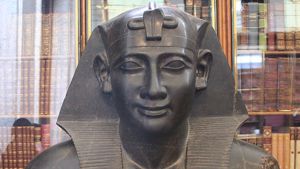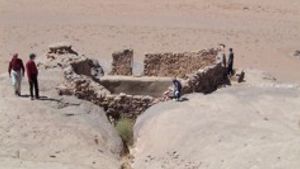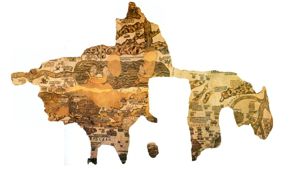Some of our readers have been surprised at the suggestion that the Nabataeans may have traveled as far as India, China, and possibly even South America. One of the arguments that they have given, is that the ancients were technologically deficient and believed that the world was flat, and thus were afraid to venture very far from home. In this short paper I would like to deal with the Flat-Earth Myth that still remains popular among uninformed scholars and historians today Even Wikipidia claims that many early civilizations subscribed to a flat earth cosmography, although they fail to provide proof of any kind. They simply point out the ancient Greeks who mention the earth is spherical, and mistakenly make assumptions that before this, a flat earth cosmosgraphy was commonly held.
First of all, it is interesting to note that nearly all scholars of the medieval period, contemporary and past, have concluded that medieval people believed the world to be round. So how did we get into the situation where a widely held believe that the ancients thought the world was flat, is so devoid of factual support? The answer to this question is provided in the very readable and authoritative historical study: Inventing the Flat Earth by Jeffery Burton Russell (1991).
Russell is a Professor of History at the University of California, Santa Barbara. His specialist knowledge is in the intellectual history of the medieval world. In his book he describes what he calls the “Flat Error.” This is the modern belief about earlier generations that tells us more about ourselves than about the people in the past.

.
The first systematic study of geography that we know of was during the time of the early Greek philosophers. Aristotelianism is particular was extraordinarily powerful as a philosophical system and Aristotle clearly taught that the earth was round. Nearly all the Greeks who had a view on the shape of the earth agreed that it was round. Erasthenes’s measurement of the earth’s circumference was 250,000 states, which is very close to the modern figure. Ptolemy came up with a smaller value, (180,000 states). These calculations were part of the classics and were recorded in the Great Library in Alexandria, known to the Nabataean sailors, used in Arab navigation, and also known to learned men in the medieval age.
During the Medieval Age it was considered very important for medieval students to learn geography, as well as astronomy and geometry. Medieval leaders such as Bede, Roger Bacon, Thomas Aquinas, Jean Buridan, Nicole Oresme, Giles of Rome and others all affirmed the earth’s sphericity. It is also interesting to note that the kings of the Early Middle Ages held a royal orb. The golden ball of the orb symbolized Christ’s sovereignty, and the message was conveyed that the king held the orb as one entrusted by God to govern.
The only identifiable ‘flat-earthers’ are Lactantius (265-345 AD), Cosmas Indicopleustes (540 AD), Severian of Gabala (380 AD), and possibly Theodore of Mopsuestia (350 - 430 AD), and possibly Diodore of Tarsus (394 AD). Of these Lactantius and Cosmas are the prime proponents of the flat earth theory. Russell, in his book, discusses both of these characters in a sympathetic way, pointing out that neither of them was influential in their own time, nor in the medieval period.
So while this theory was relatively unknown during the Middle Ages, in 1543 Lactantius was suddenly vaulted into the spotlight. Copernicus in the preface to his book, De Revolutionibus, used Lactantius to illustrate how the ignorance of opponents of the round earth was comparable to that of those insisting on geocentricity in their own time. (p 64). Copernicus did not suggest that Lactantius was in any way typical, nor did he point to any contemporaries with a similar view, but later writers picked up the name of Lactantius and made much of his bigotry and ignorance.
Next, Compte (1798-1857) developed the philosophy of positivism, with it’s concept of progress, step by step from superstition to science. This led to the idea that religion was merely a step beyond superstition and definitely a step backward from science. Then William Whewell, Vice Chancellor of Cambridge University in 1837 coined the term ‘warfare’ as describing the relationship between religion and science. Then John Draper, in The History of the Conflict between Religion and Science (1873) and Andrew Disckson White in History of the Warfare of Science with Theology in Christendom (1896) all pointed to Lactantius and Cosmas as influential leaders of the flat earth belief. These historical errors were responsible for influencing several generations of people with the idea that religion and science were in serious conflict, and that religious leaders during the medieval time held to the flat earth theory.
During this same era, an American, Washington Irving started to propagate the idea that there was opposition to Columbus’ voyage from flat-earthers. He wrote “History of the Life and Voyages of Christopher Columbus (1828) as a romantic fiction loosely based on history. Readers picked up on the idea of flat-eathers opposing Columbus, and suddenly the idea was accepted as fact by millions of people, even to the place where it found it’s way into history textbooks.
In the last hundred years, numerous articles and papers have been written to try and set the record straight, including Russell’s book Inventing the Flat Earth. However, progress has been slow, and as Russell points out, there are some lessons we can learn from the continual propagation of this myth.
Russell’s LessonsFirst, too few scholars work with primary sources. By filling their biographies and footnotes with quotes from other ‘experts and sources’ rather than primary sources the errors of other writers are repeated and propagated. This is the reason you will find Nabataea.net filled with references to the classical writers and other ancient historians, and only sparse reference to modern historians. Primary sources are vitally important, and interpretations of those sources must be regarded with care, (even the interpretations that we arrive at here at Nabataea.net.)
Second, scholars are often led by their biases, more than by the actual evidence. This is a problem that we have faced again and again on this site. Once we approached a naval historian and asked about the ancient account of Nabataeans sinking Cleopatra’s navy. We asked: “Was this a naval engagement?” The answer was, “Of course not. The Nabataeans never had a navy, so Cleopatra’s boats must have been attacked from the land.” The naval historian was simply supplying his opinion, based on his biases, rather than examining primary sources and discovering that the Nabataeans had boats, engaged the Egyptians on the Red Sea in at least one recorded sea battle, and that their ships collected incense from an island off the coast of southern Arabia and transported it north to Nabataea. The facts demonstrate that the Nabataeans had boats and knowledge of the sea, but popular bias still insists that the Nabataeans were camel drivers, not seamen.
Third, Russell points out that sociological, and cultural factors need to be recognized in scholarly work and scholars must beware of making value-judgments based on today’s norms. This is another problem that we have faced again and again here at Nabataea.net. Some of our researchers have spent more than 20 years in the Middle East, researching sociology, as well as history. Their interpretations of Nabataean history, culture, and religion differ significantly with many academic experts, who spend six weeks every two years supervising a dig in the Middle East, before returning to their teaching positions in western universities.
Fourth, some scholars have carried personal convictions about cultural superiority into their work. This has led them to undervalue the past and to erroneously attribute certain values and beliefs to those convictions. In the case of the Flat Error, as Russell calls it, there has been a conviction that the medieval period was a dark age, and that scholarship was at a low ebb and that suppression prevailed. Personal convictions and cultural superiority have also been a problem in researching and writing about Nabataeans. When one suggests that the Nabataeans sailed to India and China, eyebrows are raised. When one suggests that they visited the shores of South America, chuckles break out, and one hears comments about spending too much time in the sun. Rather than examining the evidence, such suggestions are dismissed as wild theories that should be dismissed without serious consideration.
Russell’s fifth point, is that cultural myths have a life of their own and they can reinforce each other. The Flat Earth Myth has been entangled with other erroneous ideas, such as the Dark Age, and the opposition of religion to science and so on. This may conceal a deeper agenda. Russell suggests that advocates of the Flat Error may be struggling with fears far worse than the fear of falling off the edge of the earth. They need to believe in progress in order to give meaning to life. They need to believe that our generation is superior to those that have gone before. Facing up to the implication arising from the Flat Error, or Nabataeans in America comes as an enormous cultural shock to these people. Perhaps the ancients weren’t so dumb after all. Perhaps they traveled widely, understood a great deal about science, and in some areas were more advanced than ourselves.
If you are interested in learning more, check out Russell’s book, Inventing the Flat Earth. It’s worth reading. And his five lessons are worth consideration.
Bibliography
Russell, J. B., Inventing the Flat Earth, Praeger Publishers, Westpark, Connecticut, 1991
Tyler, David, The Scandalous Flat Earth Myth, Origins Magazine, No. 31, Rugby, Warwicks, UK, July 2001




















Page Discussion
Membership is required to comment. Membership is free of charge and available to everyone over the age of 16. Just click SignUp, or make a comment below. You will need a user name and a password. The system will automatically send a code to your email address. It should arrive in a few minutes. Enter the code, and you are finished.
Members who post adverts or use inappropriate language or make disrespectful comments will have their membership removed and be barred from the site. By becoming a member you agree to our Terms of Use and our Privacy, Cookies & Ad Policies. Remember that we will never, under any circumstances, sell or give your email address or private information to anyone unless required by law. Please keep your comments on topic. Thanks!